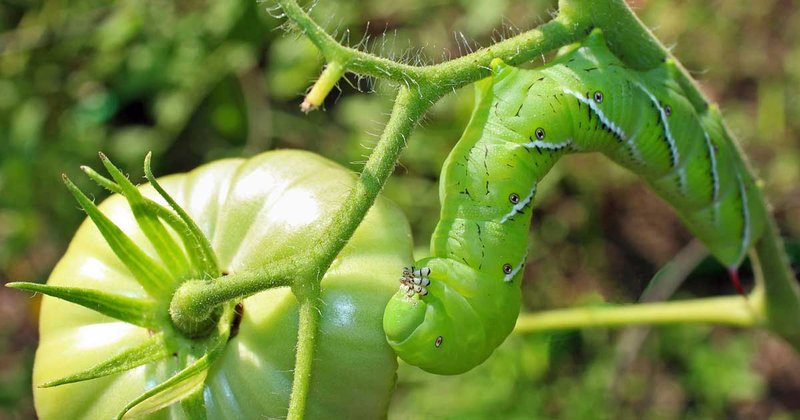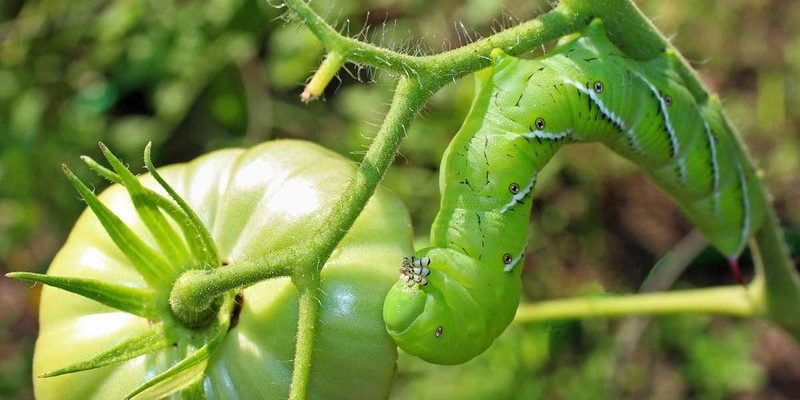
Tomato hornworms blend in so well with their environment that they can be tricky to spot. They often hide among the leaves, munching on your plants and leaving destruction in their wake. Think of them as the ultimate hide-and-seek champions of the garden. But don’t worry! Once you know what to look for, you can protect your precious veggies and keep your garden thriving.
What Are Tomato Hornworms?
Tomato hornworms belong to the family of moths known as *Sphingidae*. These caterpillars are the larvae of the **five-spotted hawk moth**. They’re known for their distinctive green bodies, which help them blend in with tomato leaves. Growing up to four inches long, they can seem intimidating, but there’s a lot more to them than meets the eye.
These pests are usually most active in late spring and summer. If you’re a gardener, you might be wondering why hornworms are such a big deal. Well, they have an insatiable appetite and can decimate a tomato plant overnight. Their size and voracious hunger allow them to consume entire leaves, flowers, and even fruits. Plus, they can reproduce quickly, making their presence all the more concerning.
How to Identify Tomato Hornworms
Identifying tomato hornworms isn’t as tricky as it might seem. Start by looking for **large green caterpillars** on or near your tomato plants. They have a distinct horn-like protrusion on their rear, which is how they get their name. Instead of just munching on the foliage, they may also be responsible for leaving behind droppings that look like small black pellets.
Here are some other signs to help you identify them:
- Color and Size: They are often bright green or greenish-brown, blending in perfectly with the leaves. They can grow as long as four inches.
- Movement: Hornworms have a unique way of moving. When disturbed, they may rear back like a snake, which can be alarming if you’re not expecting it!
- Damage: Check for chewed-up leaves and missing plant parts. You might see entire sections of leaves eaten away.
Be sure to inspect the undersides of the leaves too. Hornworms like to hide, so they may be camouflaged under foliage where you wouldn’t expect them.
Life Cycle of Tomato Hornworms
Understanding the life cycle of hornworms can help you know when to look for them. They typically go through four stages: **egg, larva, pupa, and adult moth**. The adult moth lays tiny green eggs on the underside of leaves, which hatch into larvae—those infamous tomato hornworms.
Once they emerge, these caterpillars feast on the leaves, growing rapidly in size. After a few weeks of this gluttony, they pupate in the soil, eventually emerging as adults to start the cycle all over again.
It’s good to keep an eye on your plants, especially in summer. You might catch some of the eggs or the larvae before they become a significant problem.
The Damage Hornworms Can Cause
If the presence of tomato hornworms makes your skin crawl, you’re not alone. Their appetite can lead to severe damage in a short amount of time. They not only eat leaves but can also damage flowers and fruit. This means that a single hornworm can ruin your chances of a bountiful harvest if left unchecked.
Here’s a reality check: if you’ve got a lot of hornworms, they can strip a healthy plant of its leaves in just a few days. It’s like watching a fast-forward version of garden destruction. If you spot them early, you can save your plants from becoming a buffet for these pests.
How to Control and Manage Tomato Hornworms
So, what can you do if you’ve found tomato hornworms in your garden? First things first, don’t panic! There are effective ways to manage them. Here are a few strategies:
- Handpicking: This is the most straightforward method. Just wear gloves and pick them off your plants. You can either relocate them far away from your garden or toss them in a bucket of soapy water.
- Beneficial Insects: Introduce beneficial insects like parasitic wasps, which lay their eggs on hornworms. When these eggs hatch, the larvae will feed on the hornworms, effectively controlling their population.
- Neem Oil: This natural pesticide can deter hornworms. Mix neem oil with water and spray it on your plants, but be sure to follow the instructions on the label for the best results.
You might be wondering if chemical pesticides are necessary. While they’re available, they can harm beneficial insects too. It’s usually best to start with more eco-friendly options before reaching for harsher chemicals.
Preventing Future Infestations
Once you’ve dealt with the immediate issue, you’ll want to think about how to keep hornworms from coming back. Here are a few preventive measures you can take:
- Crop Rotation: Try not to plant tomatoes in the same spot every year. Rotating crops can help disrupt the life cycle of the hornworms.
- Regular Inspections: Take time each week to inspect your plants. Early detection is key to dealing with hornworms before they can do significant damage.
- Encouraging Diversity: Plant a variety of crops and flowers around your garden. This diversity can attract beneficial insects while confusing harmful pests.
Taking these steps not only helps with hornworm prevention but also promotes a healthier and more resilient garden overall.
Tomato hornworms can seem like a gardener’s nightmare, but with a little knowledge and proactive measures, you can manage them effectively. By knowing how to identify these pests, understanding their life cycle, and taking steps to control their population, you’ll be well on your way to protecting your vegetable garden.
The best part? A few smart strategies and regular inspections can ensure your plants thrive. So, grab your gardening gloves, keep an eye out for those sneaky critters, and enjoy the fruits of your labor—literally! Happy gardening!

